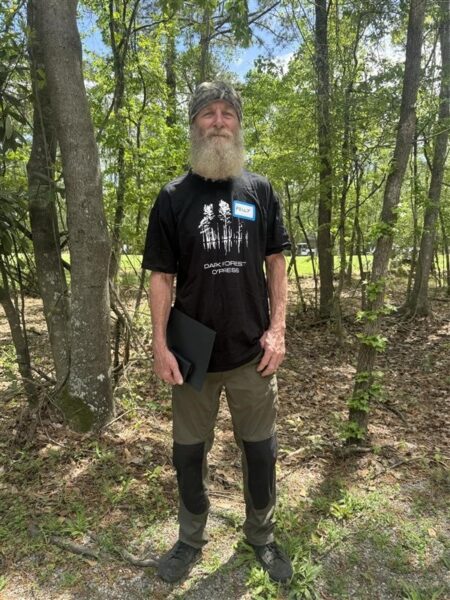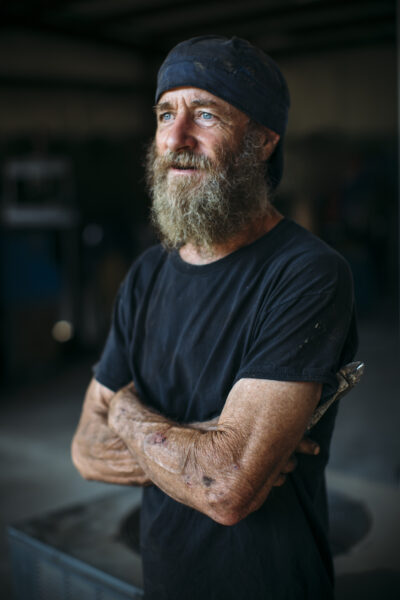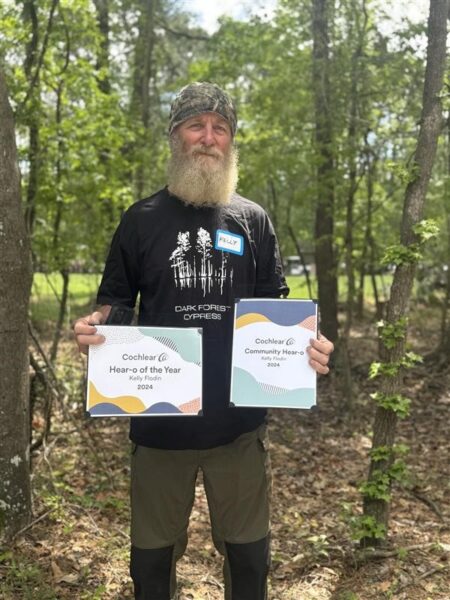2024 Hear-o of the Year winner, Kelly, sets a high standard for volunteerism and openly shares his personal experiences to help others. After years of education and perseverance, he shares his passionate journey toward enjoying music and playing guitar with bilateral cochlear implants.
Falling in love with music
“I’ve always loved music. Even as a little kid, I loved the sounds of music, loved catching the groove, loved the way it made me feel. I saved up money from odd jobs to buy myself a guitar, which has since become a lifelong fascination with music and a passion for playing with my friends and bands.
I come from a large family with hearing loss related to genetics. By my early 30s, my hearing had very noticeably declined and started to impact the way I heard music. So, I started making adjustments to how I approached playing, doing whatever it took to continue to hear in a band setting. Eventually, I needed some help and got hearing aids in my early 40s, which began a new chapter of adaptation for playing music. I never had much success playing music with my hearing aids.
Discovering cochlear implants
With progressive hearing loss, there comes a point where many of us can no longer function in a hearing world, even with the best hearing aids available. That is true with music, too. I finally hit that point in my mid-50s. I couldn’t hear well enough to fake it in a band setting anymore. I could still hear some sounds, but couldn’t understand much speech. I quit socializing, avoided going places and doing things and even changed what I did for a living. The communication struggles were too frustrating to deal with.
Thankfully, I was referred for a cochlear implant evaluation by an interim audiologist who was filling in at my hearing aid center. I dove into research and learned about the auditory system, surgery procedures, hearing rehab, etc. It seemed like a good option for me. Frustrated with my hearing aids, I was ready to do something radically different. The only thing that gave me pause was what I read about music appreciation with cochlear implants. Most articles and journals explained that while cochlear implants were great for restoring speech recognition, the complexity of music made it very difficult to be processed accurately. I realized that hearing, understanding speech and being able to communicate in everyday life were the most important things for me. I decided that if I qualified, I would jump on cochlear implants and just roll the dice on what it would do for music. Throughout my journey, I’d learn that with ample patience and thoughtful effort, music would become a major part of my life again.
Surgery went fine. I healed up for a couple of weeks, and then it was activation day. I was able to understand some speech right away. But it was so strange, high-pitched, alien and robotic. In a couple of months, speech and sounds became much more familiar and normal. I was communicating better than I had in years. It made me realize how little useful information my hearing aid was giving me. So I decided bilateral cochlear implants would be the best thing for me, and got implanted again four months later. It has been the best decision for me. Once the two cochlear implants settle in, it’s pretty amazing how well we can hear with these things.
Embarking on a musical education
After my activations, music was awful for me—just unrecognizable noise. I picked up speech pretty quickly, so my cochlear implant rehab efforts soon shifted to getting music back. I reached out to a few musicians who are cochlear implant recipients. I read everything I could find on cochlear implants and music appreciation. I spoke with Kara, my audiologist, and other researchers about cochlear implant processing, the brain and music. One thing soon became clear—it takes a lot of time, effort, perseverance and intentional music rehab for most cochlear implant users to regain music appreciation, even for just passive music listening. Playing music with a cochlear implant, on the other hand, is another animal altogether. So I took it as a challenge. This would be yet another chapter in the book of adapting to playing music with hearing loss.
I weld, fabricate and mechanic. I believe in knowing my tools, their capabilities and their limitations. I applied this thinking to my cochlear implants—my tools for listening and hearing.
Here are some key points that I have found helpful for getting music back with cochlear implants:
Understanding how cochlear implants affect music
Music is the most complex thing we listen to. In good acoustic hearing, thousands of hair cells stimulate the auditory nerve to deliver all the dynamic changes, subtle nuances, rich sounds and tones to the brain for processing. With cochlear implants, only a few electrodes take the place of all those hair cells. And they are arranged very differently along the nerve. The way cochlear implants process sound is based on amplitudes, so all the mathematics that gives us a sense of pitch and timbre is lost. The electric current used to stimulate the nerve is pretty crude compared to the precise stimulation in acoustic hearing. We lose the information that helps lock in on what we need to hear and minimize what we don’t need to hear. These are some of the limitations of our tools. But we have the biggest piece of this puzzle already—our brain.
Activating music memory
The brain is a strange, weird, amazingly powerful processor. If you feed it good, consistent bits of information over time, it will figure things out, including how we perceive music through cochlear implants.
I first set out to hear music. I made a playlist of simple, familiar songs that I knew by heart. I put the playlist on random play and tried to identify the songs without looking, which was very tough at first. Occasionally, a riff or a word would pop out of the noise, music memory would kick in, and I could follow the song along if I concentrated. The more I listened, the more this would happen, and it became easier to recognize and hear music. Encouraged, I checked out other types of music. I found that some genres translated to cochlear implants much better than others. For me, simple stuff with a strong backbeat worked best. I streamed music all day while I worked, and slowly, passively listening to music began to fall into place—I started enjoying it.
Playing music again
Then, I got out my guitar and started playing every evening. I realized I needed to work with my audiologist to adjust my cochlear implant programs to hear my guitar better. It may seem a little counterintuitive, but this is one of the things I feel made a huge difference in the way I hear music. They were loud and harsh at first, but I could hear my guitar so much better. I started listening to all my music with them, and soon preferred them for everything—letting everything in so the brain could do its thing.
Pitch perception was another issue. Everything I hear is electric, and I have no acoustic information. Pitch perception is crucial for playing music, and it’s up to the brain to come up with new ways to regain a sense of pitch. And we can do our part by loading it with information. In this case, a lot of music.
I did this by playing familiar, simple scales that I’ve played for decades. At first, it sounded like the same note. Then I started hearing very inaccurate intervals, or sometimes reversals. I would play ascending, and it sounded like descending. Slowly, as time went by, it began to sound more accurate. When I moved on to playing familiar melodies and riffs, it started being fun again. I now consider playing guitar, or any instrument, to be the very best cochlear implant rehab tool. There is something about the music and muscle memory, the motor movements, watching my hands on the fretboard, and feeling the vibrations that gives the brain so much more information to work with to regain a sense of pitch.
Practicing pitch
There are also some cool apps for honing pitch. I like PerfectEar—it helps musicians train their ears and offers many scale and interval recognition exercises. Not only does honing pitch perception make music better and playing music possible, but it also makes everything we hear sound more normal and natural. It helps to track one sound among many sounds more easily, so we hear better in noisy places.
After several years of work, I think I have a good sense of relative pitch. It’s still different from true pitch, but it works fine for playing guitar. I continue to try and hear things more accurately. It will be an ongoing process that I hope to enjoy for a long time.
Gaining a new perspective
Music is still different than my memories of it from long ago. The dynamic range is compressed, soft things are pretty loud, and loud things are not much louder. Timbre is different, a little less defined, a little harder edged. There can still be pitch confusion, and I have to pay more attention to not play out of key. The more complex the music, the harder it is for me to hear what I need to play. Tone, the holy grail we all search for as guitar players, is not that important to me anymore. All amps and guitars sound decent, but pretty much the same.
This brings me to perspective. If I compare what I hear now with my memories, I could be disappointed. But when I compare it to where I was with my old hearing aids, I’m happy with how I hear music now. Even though it’s different, I still get a kick out of music. I’m back to playing with my friends and having fun with it. I no longer try to hear it as I once did; I just try to hear it the best I possibly can now.
My cochlear implants have been life-changing. They have allowed me to get back to living my life in a hearing world as I’ve always known it. Getting music back feels like a big bonus. It takes a lot of patience, effort and perseverance, but it’s very rewarding when things fall into place. I’m grateful for the technology and all the good people that make it happen—the doctors and audiologists, advocacy and awareness organizations, countless researchers and engineers, and all my fellow cochlear implant users who push the boundaries with their hardware. Rock on!”



